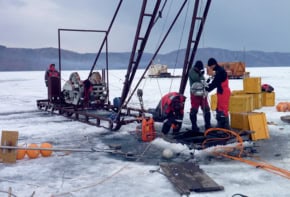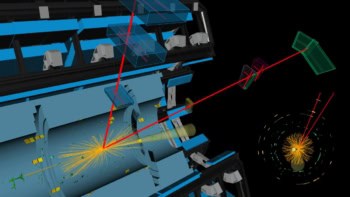Particle physicists have made the most accurate ever measurements of the properties of an exotic atom known as kaonic hydrogen. In this atom a negative kaon orbits around a proton, similar to the way an electron orbits around a proton in a hydrogen atom (Phys. Rev. Lett. 94 212302). The results will help physicists learn more about the symmetry breaking processes that generate the masses of particles, and also about the strong force that holds protons, neutrons and other particles together.

Understanding quantum chromodynamics or QCD – the theory of the strong force – at low energies requires knowledge of the scattering length that describes the interactions between particles at zero kinetic energy. However, the only direct way to determine this length is to measure the energy of the X-rays that are emitted when excited kaonic hydrogen atoms decay to their ground state.
The DEAR experiment at the INFN Laboratory in Frascati, Italy, fires low energy kaons onto a gaseous hydrogen target. The experiment relies on electron-positron collisions at the DAφNE accelerator that create φ-particles which, in turn, decay into kaons. Kaonic hydrogen forms when a negative kaon collides with a hydrogen atom, loses its kinetic energy and then replaces the electron in an excited orbit around the proton. The X-rays are emitted when the kaon drops into the ground (1s) state.
When the kaon reaches the ground state the strong interaction between it and the proton comes into play. This causes the energy of the 1s state to shift in energy and to become broader. The DEAR experiment has now used a new CCD X-ray detector to measure these values more accurately than ever before. Moreover, the DEAR team was able to identify X-rays caused by transitions from different excited states for the first time (see figure).
“A precise determination of the antikaon-nucleon scattering length puts strong constraints on the process of chiral symmetry breaking,” says DEAR spokesperson Carlo Guaraldo. “A better understanding of this process is, in turn, fundamental for our comprehension of QCD in the low-energy limit. ”
The DEAR collaboration now hopes to make measurements that are 10 times more precise at a new experiment called SIDDHARTA, which should also be able to probe the properties of kaonic deuterium for the first time. Meanwhile, the FINUDA experiment at Frascati has seen evidence for a bound state containing an antikaon and two protons (Phys. Rev. Lett. 94 212303).



